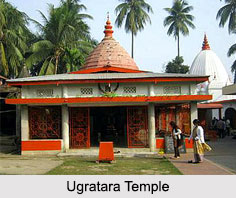 Located in the heart of the Guwahati city in the state of Assam, the Ugratara Temple is situated in the Uzan Bazaar, which is a residential and commercial centre but one of the oldest settlements in the city. Built by the Ahom king Siva Singha in 1725 AD, the Ugratara Temple is a Shakti shrine that is dedicated to Goddess Tara.
Located in the heart of the Guwahati city in the state of Assam, the Ugratara Temple is situated in the Uzan Bazaar, which is a residential and commercial centre but one of the oldest settlements in the city. Built by the Ahom king Siva Singha in 1725 AD, the Ugratara Temple is a Shakti shrine that is dedicated to Goddess Tara.
Legends of Ugratara Temple
As per legends, it is said that the navel of Sati, the first consort of Lord Shiva, had fallen at this particular place where the Ugratara Temple is situated. There are other legends surrounding the temple. According to the Sthala Purana, once Yama, the Lord of Hell was disgruntled that nobody from Kamarupa was coming down to Hell due to the sacredness of the place. In order to fix that, he made a complaint to Lord Brahma, who in turn took his complaint to Lord Vishnu and finally the issue was brought under the attention of Lord Shiva.
Lord Shiva took the matter in his own hands and ordered Goddess Ugratara along with her army to drive away all the people of Kamarupa. In the course of this drive, Saint Vasistha was doing penances to Lord Shiva on the Sandhyachal hill. When Ugratara and her army laid hands on the sage, he was livid and cursed the Goddess and also Lord Shiva himself. He cursed Ugratara to be worshipped according to the Vamachara or left handed rites and Kamarupa would no longer have any kind of Vedic rituals.
Other legends state that the existence of the Ugratara Temple connects it with Buddhism, identified to Eka Jata and Tiksna Kanta of the Buddhist pantheon. There are similarities between Buddhist and Hindu Goddess Tara indicating some religious communications between both the religions.
Design of Ugratara Temple
In the sanctum sanctorum of the Ugratara Temple, there is no image or idol of the goddess instead there is a small pit of water that is considered as the deity. The Ugratara Temple is an octagonal brick structure beside which is a Shiva temple and behind both of these temples is a pond. On the eastern part of the temple complex is a water tank called Jor Pukhuri built by Siva Singha, here "Jor" meaning pair and "Pukhuri" meaning tank.
It is said that the structure of the temple was rebuilt in the modern era after it was completely damaged by a major earthquake in Assam.
Visiting Information on Ugaratara Temple
The Guwahati railway station is the closest at a distance of about 1.3 km from the temple and the Lokpriya Bordoloi International Airport is the nearest at a distance of almost 30 km from the temple.



















